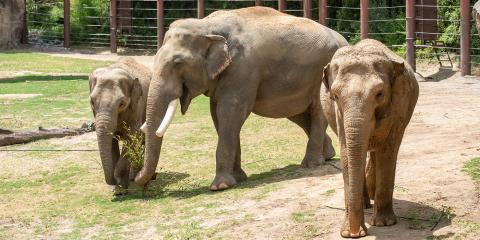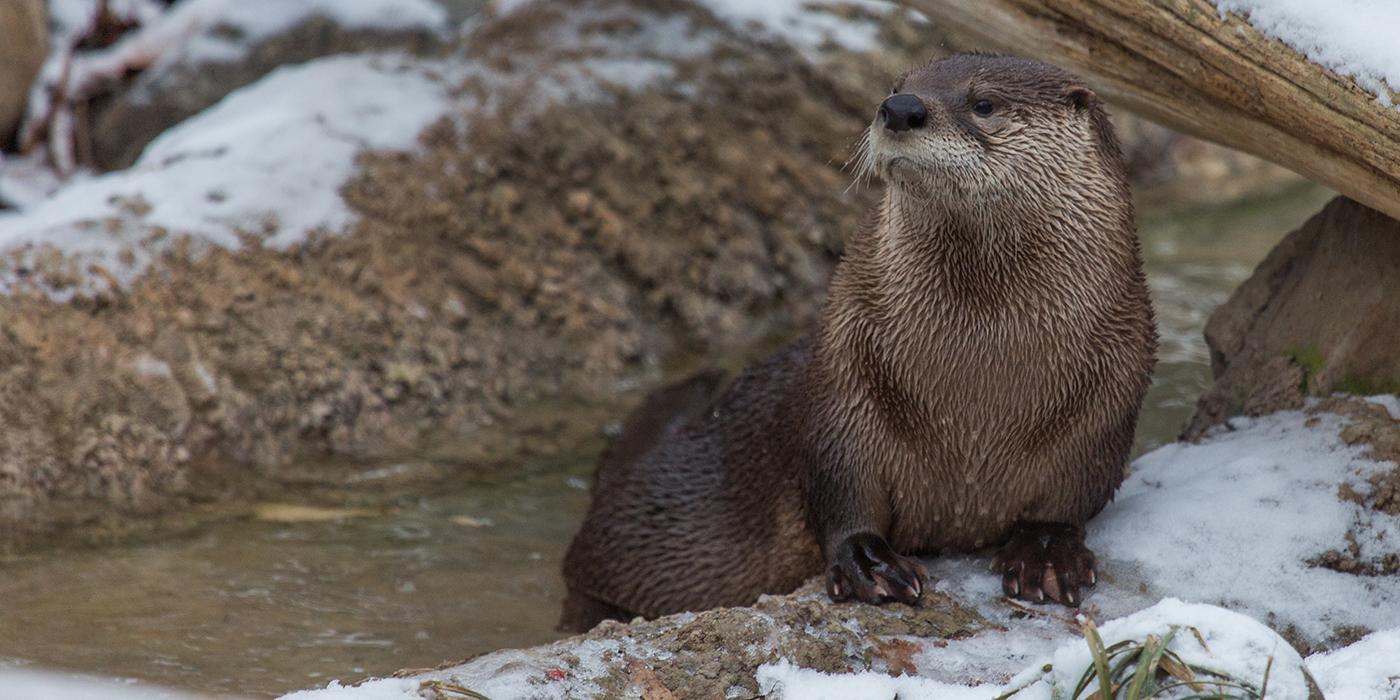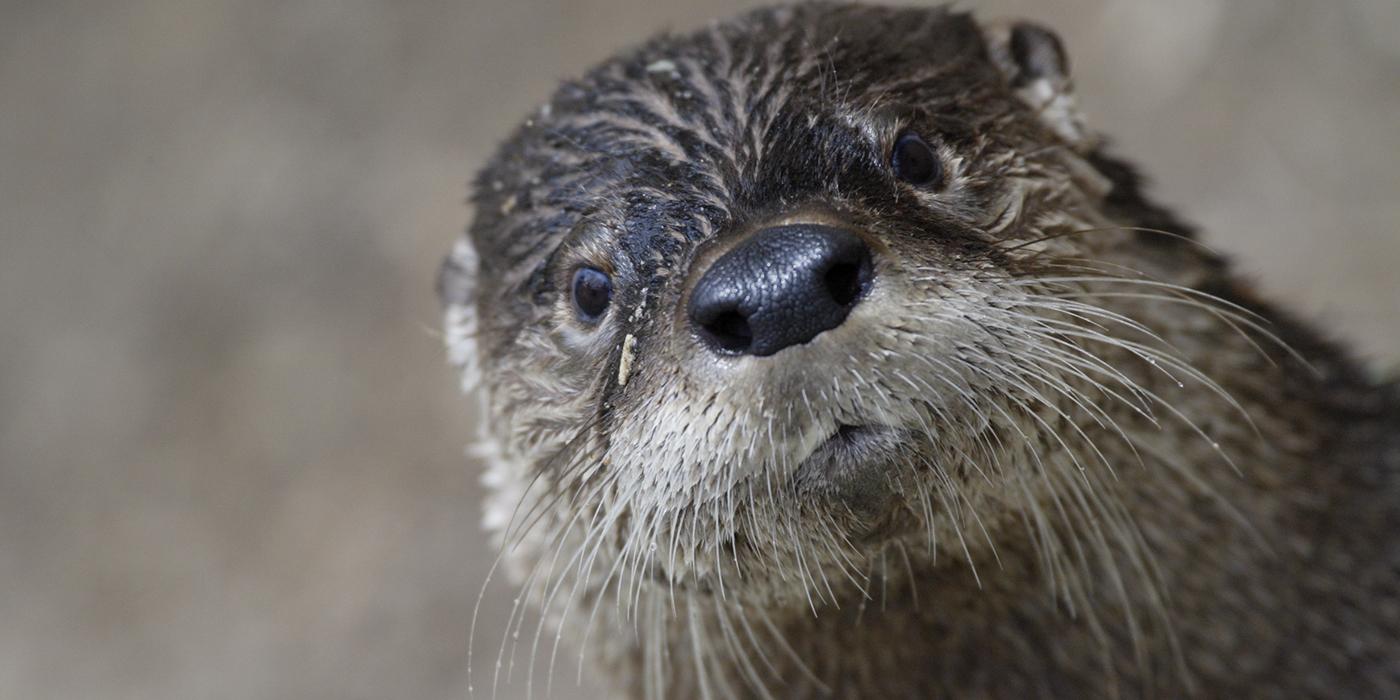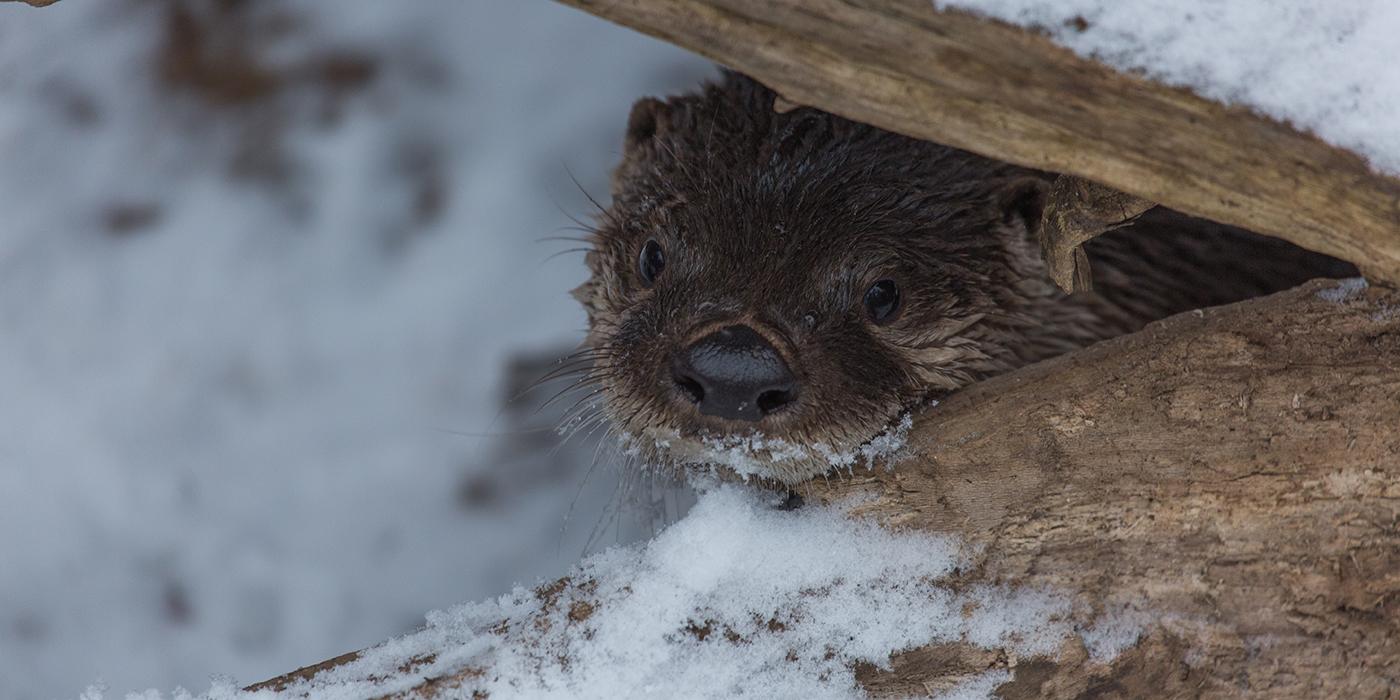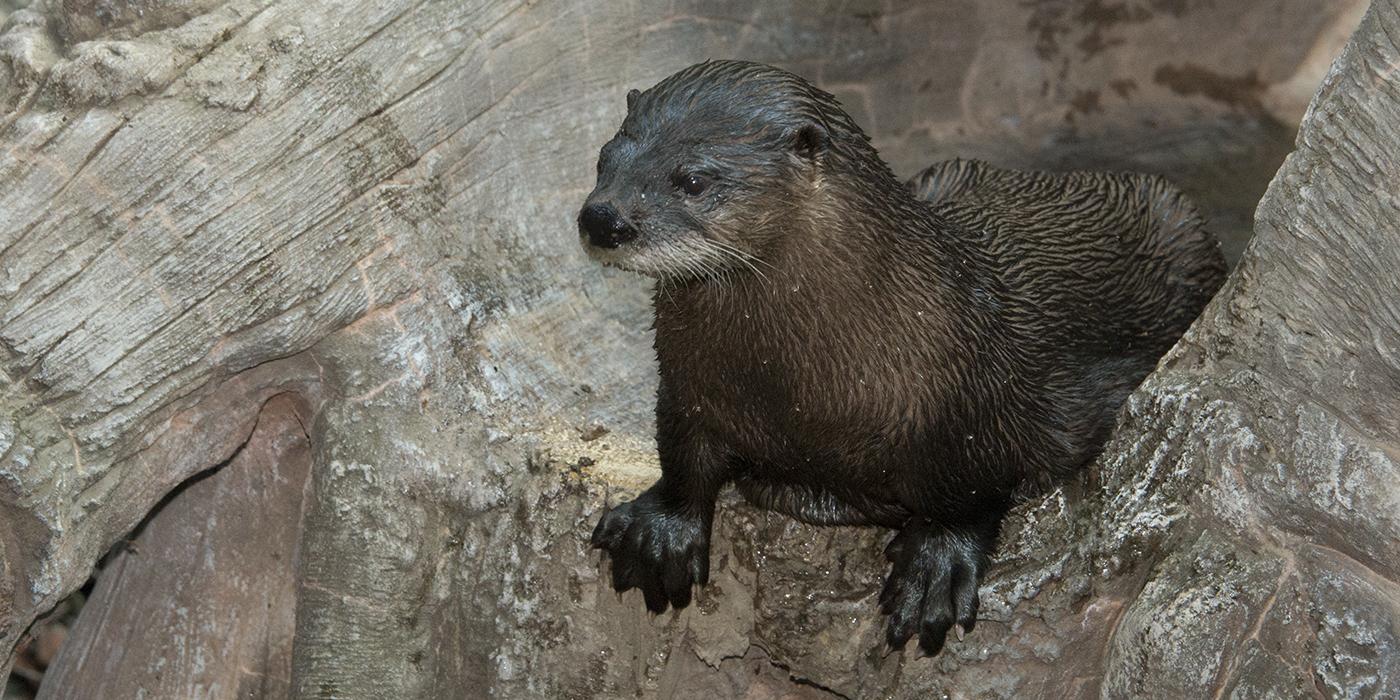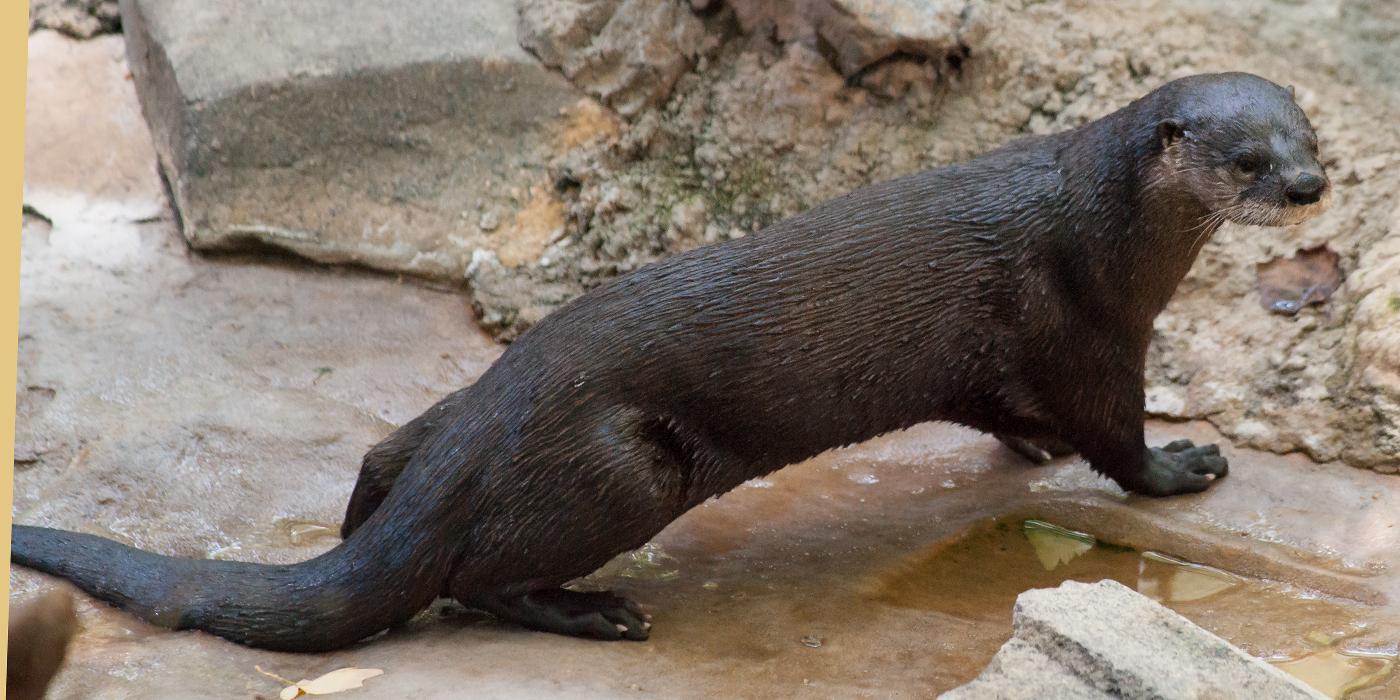Physical Description
North American river otters, also called Canadian otters, have long, muscular, streamlined bodies with short legs and fully webbed feet bearing non-retractable claws. Their small heads widen to long necks and shoulders, and they have flattened, well-muscled tails. These otters have brown-to-gray fur, and their undersides are a lighter, silvery shade. Their dense, short under-fur is overlain by darker, coarse guard hairs that help repel water.
The river otter's eyes and ears are located high on its head for surface swimming. A third eyelid, or nictitating membrane, protects the eye and allows the otter to see when swimming underwater. The otter's ears and nostrils close underwater.
River otters have long, stiff and highly sensitive facial whiskers that aid in locating and capturing prey. The otters typically capture prey in their mouths but occasionally use their thumbs and forepaws to grasp and manipulate prey. Like other carnivores, their teeth are well adapted for grinding and crushing.
The tail is highly muscular and comprises up to 40 percent of the otter's total body length. With the tail's strong, undulating movement, a river otter propels itself through the water as fast as 8 miles (13 kilometers) per hour and can easily dive to 36 feet (11 meters) or more. River otters use their powerful hind feet to help with propulsion and their small, dexterous front feet for paddling through the water.
Size
Adult river otters weigh 10 to 33 pounds (4.5 to 15 kilograms) and are about 2.5 to 5 feet (76 to 152 centimeters) in length. Females are roughly one-third the size of males.
Native Habitat
River otters are found throughout most of North America from the Rio Grande to Canada and Alaska, except for in arid deserts and the treeless Arctic. They live in riparian zones, often in the same areas as beavers. Their aquatic habitats can be both marine and fresh water: streams, rivers, lakes, ponds and marshes.
They prefer unpolluted water with a minimal human disturbance. An extremely adaptable animal, otters tolerate hot and cold climates, as well as high elevations and lowland coastal waters.
Lifespan
Provided it survives its first year of life, a typical North American river otter will live to the age of 12, with some surviving longer. The oldest living river otter on record was 27 years old.
Communication
River otters exhibit a variety of vocalizations, ranging from whistles and buzzes to twitters, staccato chuckles, chirps and growls. When threatened or frightened, they emit a hair-raising scream that can be heard up to 1.5 miles (2.4 kilometers) across the water.
River otters leave scent marks on vegetation within their home range. Scent marking is done by either urinating/defecating or by emitting a strong, musky odor from the paired scent glands near the base of the tail.
Food/Eating Habits
River otters eat mostly aquatic organisms, including fish, frogs, crayfish, turtles, insects and some small mammals. They hunt singly or in pairs and although otters generally forage in water, they are equally at home on land, sometimes traveling between 10 and 18 miles (16 and 29 kilometers) in search of food.
North American river otters get their boundless energy from their very high metabolism, which also requires that they eat a great deal during the day. At the Smithsonian's National Zoo, they eat a prepared meat diet and several types of fish. They also receive mice, carrots, hard-boiled eggs, clams, crayfish, dry kibble, crickets and live fish for variety and enrichment.
Social Structure
A North American river otter's home range can be as large as 30 square miles (78 square kilometers), but a typical territory is 3 to 15 square miles (4.8 to 24 square kilometers). That home range shrinks drastically during breeding and rearing season.
While river otters tend to live alone or in pairs, they often socialize in groups and are known for their playful behavior. Their long, agile bodies enable them to quickly twist , turn, roll and dive, and they are frequently seen sliding or burrowing in the mud or snow. There is evidence that river otters' play activities strengthen social bonds, improve hunting techniques and scent mark territories. They spend a significant portion of the day scent marking territory by urinating, defecating, scratching and rubbing their scent glands on rocks and trees.
Reproduction and Development
Information about river otter breeding and reproductive and social behavior is varied due to the difficulty of studying these animals in the wild. Some studies indicate that river otters pair for only a few months during the breeding season and have no further strong bonds. Other research maintains that river otters mate for life.
Different studies have placed the breeding season in winter, late spring and summer. What is clear is that there is a delayed implantation of nine to 11 months, with actual gestation taking about 60 days. Otter births occur most frequently in March or April.
Female otters prepare dens that they keep scrupulously clean. The den is usually dug into the bank of a stream but can be an old beaver's lodge, muskrat house or hollow tree. Young are born between April and May and arrive silky black, blind, toothless and totally helpless. They weigh about 4 to 6 ounces (113 to 170 grams) at birth and measure 8 to 11 inches (20 to 28 centimeters). The male otter is generally chased away until the young are weaned and old enough to leave the riverbank, at which time they may return and help raise the pups.
River otters stay in family groups during the summer and early fall. Pups grow rapidly and emerge from the den at about 2 months of age. At this point, they eat solid food but are not completely weaned for another month or two. While young otters swim naturally, the mother must coax them into the water for their first swim. They remain as a family unit for seven to eight months or until the birth of a new litter. Otters reach sexual maturity at 2 to 3 years of age.
Conservation Efforts
North American river otters are likely the most numerous of the otter species. Because they are at the top of their food chain, they have few predators. However, water pollution, uncontrolled trapping and severe habitat loss have reduced the number of river otters.
For years, river otters have been hunted for their fur, and their pelts are still an important source of income for many people in Canada. As recently as the mid-1980s, more than 30,000 pelts were harvested annually. Today, accidental trappings in beaver traps constitute the most otter fatalities.
Regionally extinct throughout the Midwest and heavily populated areas in the east, several states have recently begun reintroduction programs. It is encouraging to note that with these conservation programs, regulations on trapping and the improvement of water quality, the river otters are finally making a comeback in certain wetland areas.
Because they have a low tolerance for polluted water, river otters are considered by some naturalists to be a good indicator, or "keystone," species of the quality of aquatic habitats. They are found at the top of the food chain, and there is some evidence that their birth rates are reduced when pollution levels—including toxic chemicals, heavy metals, pesticides and agricultural wastes—build up.
River otters have been blamed for decimating game fish populations and are seen as a pest to eradicate by many game fishermen. Recent research, however, indicates that otters prefer slower moving, easier to catch fish, such as suckers and catfish found along river bottoms, and pose no threat to game fish.
Help this Species
- Organize or attend a stream, river, lake or other waterway cleanup in your area to preserve aquatic habitats for local species.
- Are you a hunter? You can be an incredible ally for conservation! Check the conservation status of the animals you hunt and use methods that don’t impact other animals.
- Protect local waterways by using fewer pesticides when caring for your garden or lawn. Using fertilizers sparingly, keeping storm drains free of litter and picking up after your pet can also improve watershed health.
Meet the Animals
Two male otters, a father and son pair named Emmett and Potomac, live on American Trail.
Animal News
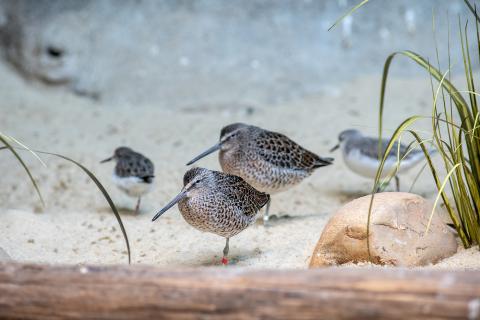
Why Do Shorebirds Stand on One Leg?
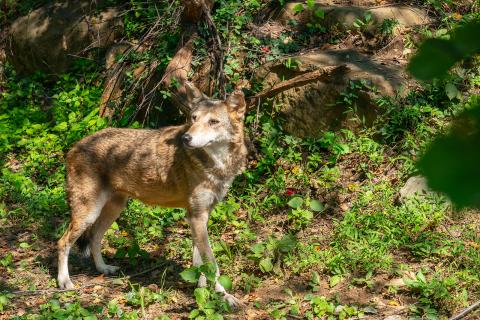
Ask a Keeper: Where Are the Red Wolves Hiding?
